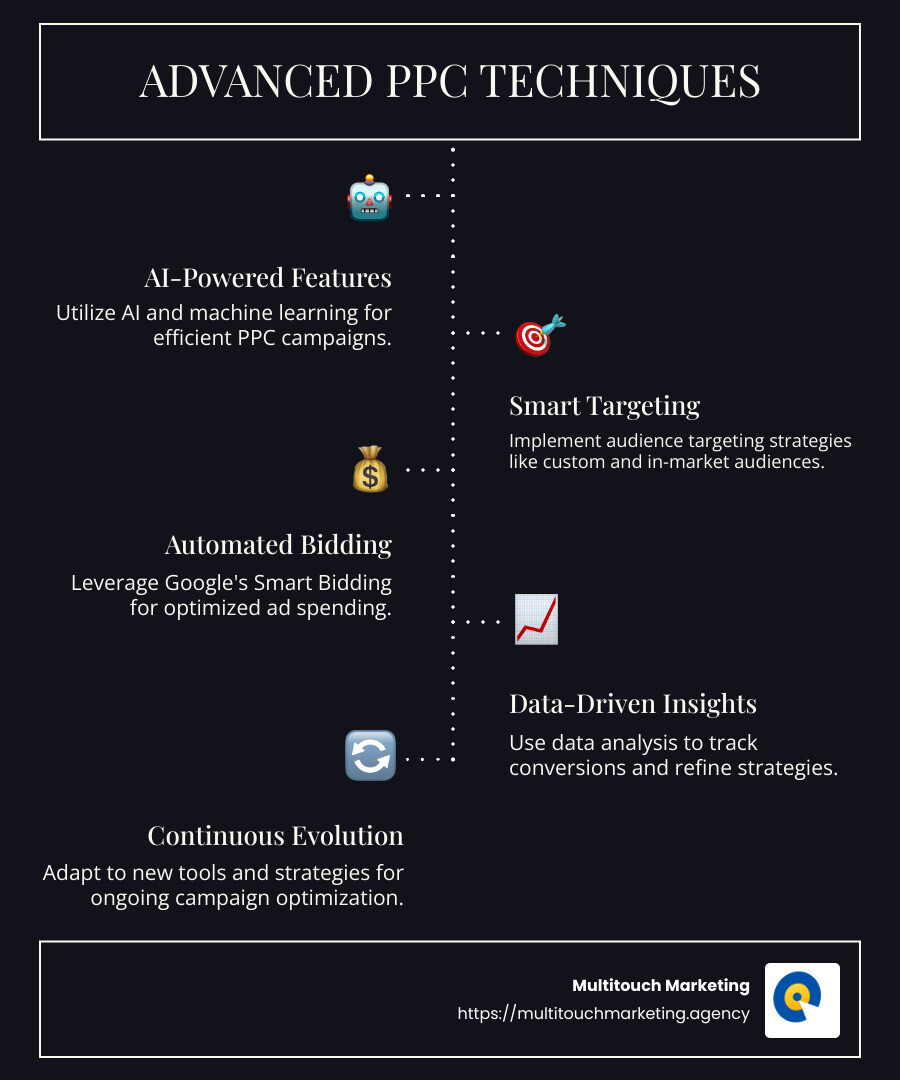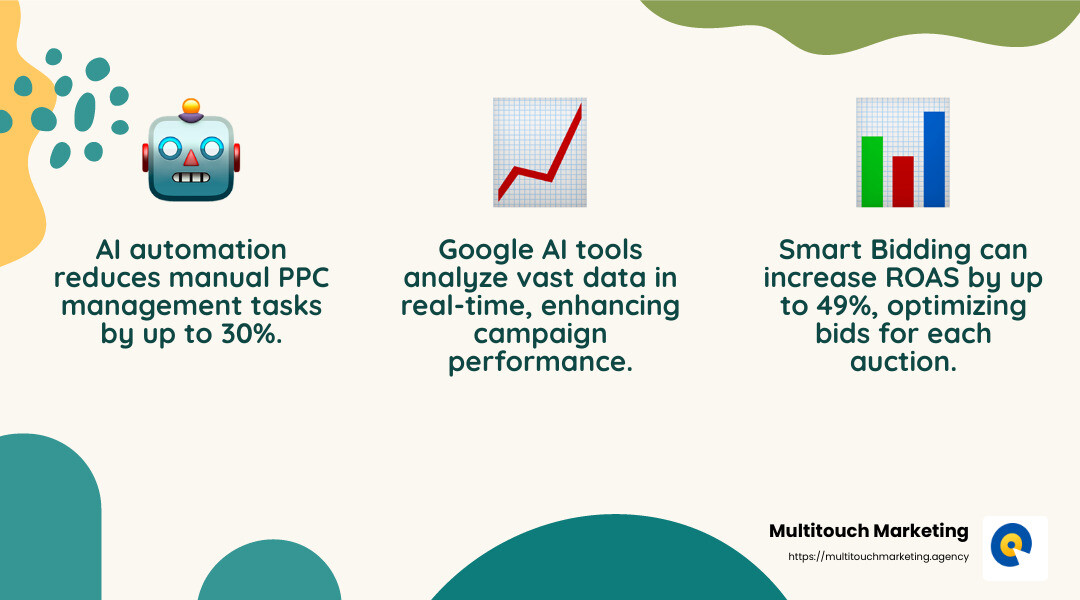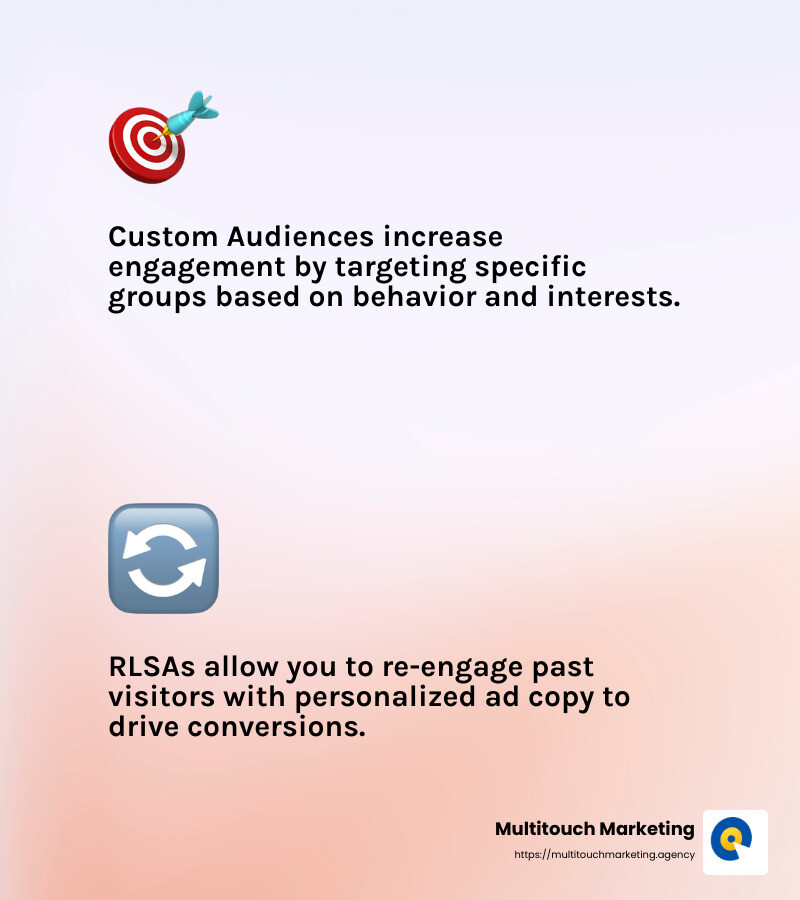Advanced PPC techniques are crucial for businesses aiming to steer today’s competitive digital landscape successfully. If you’re looking for quick tips, here are essential tactics:
- AI-Powered Features: Use AI and machine learning for a more efficient PPC campaign.
- Smart Targeting: Implement audience targeting strategies, including custom and in-market audiences.
- Automated Bidding: Leverage Google’s Smart Bidding for optimized ad spending.
- Data-Driven Insights: Use data analysis to track conversions and refine your campaign strategy.
Over the years, PPC advertising has evolved far beyond simple keyword bidding. Today’s landscape demands a more sophisticated approach to digital marketing. With these advancements, campaign optimization becomes a continuous journey of adapting to new tools and strategies. The right PPC strategies not only improve online visibility but also drive significant revenue growth and cost efficiency for businesses.
I’m Milton Brown. I specialize in Advanced PPC techniques and have experience in digital marketing across multiple industries. Since 2008, I have crafted and managed campaigns with budgets ranging from $20,000 to $5 million, helping businesses achieve substantial returns through strategic PPC efforts.
Easy Advanced PPC techniques glossary:
Advanced PPC Techniques for 2025
In the changing world of digital marketing, PPC strategies are continuously advancing. Advanced PPC techniques are essential for staying ahead of the competition. Let’s explore some key tactics that will define successful campaigns in 2025.
AI-Powered Features
Artificial Intelligence (AI) is revolutionizing PPC advertising. By leveraging AI-powered tools, marketers can automate and optimize campaigns more efficiently. Google’s Smart Bidding, for example, uses AI to adjust bids in real time, ensuring ads appear when conversions are most likely. This technology has shown impressive results, as evidenced by a case study on FishingBooker, which experienced a 49% increase in ROAS and a 57% boost in conversions.
AI-driven features also allow marketers to analyze vast amounts of data quickly, providing insights that were previously unattainable. This enables more strategic decision-making and improves overall campaign performance.
Automated Bidding
Automated bidding is another game-changer in PPC strategies. It reduces the manual workload and ensures that bids are set to achieve the best possible outcomes. Google’s automated bidding strategies, such as Target CPA and Target ROAS, adjust bids based on real-time data, including user device, location, and time of day.
By automating these processes, businesses can focus on other critical aspects of their campaigns, like creative development and audience engagement. This approach not only saves time but also improves the efficiency of ad spend, leading to better ROI.
Smart Targeting
Smart targeting is about reaching the right audience with the right message at the right time. With advanced targeting options, such as custom audiences and in-market audiences, businesses can tailor their ads to specific user groups based on interests, behaviors, and past interactions.
For instance, dynamic remarketing allows businesses to show ads to users who have previously interacted with their brand, offering personalized messages that resonate with their journey. This level of personalization significantly reduces ad fatigue and increases the likelihood of conversion.
In 2025, successful PPC campaigns will leverage these advanced targeting strategies to create more relevant and engaging ad experiences. By focusing on the needs and behaviors of their audience, businesses can drive higher conversion rates and maximize their advertising efforts.
The landscape of PPC is rapidly changing, and embracing these Advanced PPC techniques will be crucial for marketers looking to thrive in the digital space. The integration of AI, automation, and smart targeting will continue to shape the future of PPC advertising, providing businesses with powerful tools to achieve their marketing goals.
Using AI and Machine Learning
In the world of PPC, automation is your secret weapon. AI and machine learning are changing how marketers manage campaigns, making them more efficient and effective. Let’s explore how these technologies are shaping the future of PPC.
PPC Automation
Imagine a world where routine tasks like bid adjustments and keyword updates are handled automatically. That’s the power of PPC automation. By leveraging AI, you can reduce the manual workload and focus on strategic tasks that drive growth. Automated systems take care of the nitty-gritty details, freeing up your time to get creative and think big.
Smart Bidding
One of the standout features of AI in PPC is Smart Bidding. Google’s Smart Bidding uses machine learning to optimize bids for each auction, considering factors like user behavior, device, and location. The results speak for themselves. A case study on FishingBooker showed a 49% increase in ROAS and a 57% boost in conversions after implementing an ROAS automated bidding strategy.
Smart Bidding ensures your ads appear when they’re most likely to convert, maximizing your return on investment with minimal effort.
Google AI
Google AI is at the forefront of PPC innovation. With tools like Target CPA and Target ROAS, you can set specific goals and let AI do the heavy lifting. These tools analyze vast amounts of data in real time, adjusting bids to meet your objectives. It’s like having a personal assistant who’s always on the job, ensuring your campaigns are performing at their best.
But Google AI isn’t just about automation. It also provides valuable insights into campaign performance, helping you make data-driven decisions. By understanding what’s working and what’s not, you can fine-tune your strategy for even better results.
Incorporating AI and machine learning into your PPC strategy is no longer optional—it’s essential. As competition heats up, these technologies will give you the edge you need to stay ahead. Accept the power of AI and watch your campaigns soar.
Personalization and Audience Targeting
In today’s competitive PPC landscape, understanding your audience is key. Advanced PPC techniques like creating custom audiences and leveraging in-market audiences and RLSAs can significantly improve your ad targeting strategy.
Custom Audiences
Custom audiences allow you to tailor your advertising to specific groups based on their behaviors, interests, and demographics. By using tools like Google Analytics and CRM data, you can create detailed audience segments that reflect the unique needs and preferences of your target market. This ensures that your message resonates with the right people, increasing engagement and conversion rates.
For example, if you’re selling eco-friendly products, you might create a custom audience of environmentally conscious consumers who have previously interacted with similar brands or content. This targeted approach ensures your ads are reaching individuals who are more likely to be interested in your offerings.
In-Market Audiences
In-market audiences are curated by Google and consist of users actively researching and considering specific products or services. These audiences are already convinced of the general benefits of what you’re offering, so your job is to highlight your brand’s unique selling points (USPs).
To find in-market audiences relevant to your campaign, steer to the Audiences tab in your Google Ads account. By selecting “Edit Audience Segments” and then “Browse,” you can explore available groupings by industry and add the most relevant ones to your campaigns. This targeted strategy can significantly improve your campaign’s effectiveness by focusing on users who are ready to make a purchase.
RLSAs (Remarketing Lists for Search Ads)
RLSAs are a powerful tool for re-engaging users who have previously visited your website without converting. By using RLSAs, you can customize your ad copy to entice these potential customers to return and complete their purchase. This is especially useful for products with longer sales cycles, like hot tubs or high-end electronics, where consumers often spend more time considering their options.
To effectively use RLSAs, create separate ad groups or campaigns to differentiate these audiences from other custom or in-market audiences. This segmentation allows for more personalized messaging, such as offering a discount code or highlighting a unique feature of your product, to encourage conversion.
Key Takeaway: Personalization and precise audience targeting are crucial components of a successful PPC strategy. By leveraging custom audiences, in-market audiences, and RLSAs, you can deliver hyper-relevant ads that speak directly to your potential customers’ needs and interests.
These advanced targeting strategies not only improve engagement but also maximize your return on investment by ensuring your ads are seen by those most likely to convert.
Next up, we’ll dive into how data-driven optimization can further improve your PPC campaigns.
Data-Driven Optimization
In Advanced PPC techniques, data is your best friend. It guides every decision, from choosing keywords to crafting ad copy. Let’s explore how conversion tracking, conversion events, and data analysis can boost your campaigns.
Conversion Tracking
Conversion tracking is like having a GPS for your PPC campaigns. It tells you exactly where your conversions are coming from and how they’re happening. By setting up conversion tracking in your Google Ads account, you can see which ads, keywords, and audience segments are driving the most valuable actions, like purchases or sign-ups.
How to Set It Up:
- Access Google Ads: Go to the “Tools & Settings” menu and select “Conversions.”
- Create Conversion Actions: Define what you consider a conversion (e.g., a completed purchase, form submission, etc.).
- Install Tracking Code: Add the conversion tracking tag to your website to start gathering data.
Tracking conversions allows you to identify the successful elements of your campaign and allocate more budget to those areas.
Conversion Events
Conversion events are specific actions you want users to take on your website. These could be anything from signing up for a newsletter to completing a purchase. By defining and tracking these events, you can understand how users interact with your site and where they drop off in the conversion funnel.
Example:
Let’s say you’re running a campaign for a SaaS product. You might track events like “Free Trial Sign-Up” or “Demo Request.” By analyzing these events, you can see which steps in the process need improvement to increase conversions.
Data Analysis
Data analysis is the backbone of any successful PPC strategy. It helps you make informed decisions based on real-world performance rather than guesswork. Using tools like Google Analytics and third-party platforms, you can dive deep into your campaign data to uncover trends and insights.
Key Metrics to Analyze:
- Click-Through Rate (CTR): Indicates how often people click on your ad after seeing it.
- Cost Per Conversion: Helps you understand how much you’re spending to acquire a customer.
- Bounce Rate: Shows how many visitors leave your site after viewing only one page.
By regularly analyzing these metrics, you can tweak your campaigns for better results. For instance, if you notice a high bounce rate, it might be time to optimize your landing page for a better user experience.
Key Takeaway: Data-driven optimization is essential for maximizing the effectiveness of your PPC campaigns. By leveraging conversion tracking, monitoring conversion events, and analyzing data, you can make smarter decisions that lead to better performance and higher ROI.
Next, we’ll discuss how cross-platform PPC campaigns can broaden your reach and improve your marketing strategy.
Cross-Platform PPC Campaigns
In the field of Advanced PPC techniques, sticking to just one platform can limit your potential. To truly maximize your reach, adopt a multi-channel approach. This means leveraging platforms like Google Ads and LinkedIn Ads to create a cohesive and powerful PPC strategy.
Google Ads
Google Ads is often the go-to platform for many marketers. It’s like the Swiss Army knife of PPC. With its vast reach and robust targeting options, you can connect with users actively searching for products and services like yours.
Key Features:
- Automated Bidding: Let Google’s machine learning optimize your bids for maximum conversions.
- Smart Campaigns: Ideal for small businesses, these campaigns automate much of the setup process.
- Responsive Search Ads: Create multiple versions of your ad copy to see which performs best.
LinkedIn Ads
While Google Ads is great for reaching a broad audience, LinkedIn Ads is perfect for B2B marketing. It allows you to target professionals based on job title, industry, and even company size. This makes it an invaluable tool for reaching decision-makers.
Benefits of LinkedIn Ads:
- Precision Targeting: Reach specific job titles or industries.
- Sponsored Content and InMail: Engage users with personalized messages directly in their inbox.
- Matched Audiences: Retarget website visitors or LinkedIn Page followers with custom content.
Multi-Channel Strategies
Using a combination of platforms not only broadens your reach but also ensures that you’re present wherever your audience spends their time. For instance, you can use Google Ads to capture intent-based searches and LinkedIn Ads to nurture leads through professional engagement.
Steps to Implement Multi-Channel Strategies:
- Identify Your Audience: Understand where your potential customers spend their time online.
- Set Unified Goals: Ensure your campaigns across different platforms are working towards the same objectives.
- Sync Audiences: Use tools like LinkedIn’s Matched Audiences and Google’s Customer Match to maintain consistency.
- Monitor and Adjust: Continuously analyze performance across platforms and adjust your budget based on where you’re seeing the best results.
Example:
A cybersecurity firm might use LinkedIn Ads to target CISOs with educational content and Google Ads to capture search traffic related to specific security solutions. This dual approach ensures they are reaching potential clients at different stages of the buying journey.
Takeaway: By employing cross-platform PPC campaigns, you can create a more comprehensive marketing strategy that captures potential leads across multiple touchpoints. This approach not only broadens your reach but also ensures that your message is consistent and relevant, no matter where your audience finds you.
Next, we’ll dive into some frequently asked questions about Advanced PPC techniques to further improve your understanding.
Frequently Asked Questions about Advanced PPC Techniques
What are the benefits of AI in PPC?
AI is like having a super-smart assistant for your PPC campaigns. It brings efficiency, scalability, and improved performance to the table.
- Efficiency: AI can automate tedious tasks like bid adjustments and ad placements, freeing you to focus on strategy and creativity. For example, Google’s Smart Bidding optimizes bids in real-time, ensuring that each cent of your budget works its hardest.
- Scalability: As your business grows, AI helps manage larger campaigns without additional manual effort. It can analyze vast amounts of data quickly, making it easier to scale your PPC efforts across multiple platforms.
- Performance: AI-driven insights can improve your campaign performance by identifying trends and opportunities you might miss. With machine learning, AI continually learns and adapts, improving your ad targeting and increasing conversion rates over time.
How can I optimize my PPC campaigns?
Optimizing PPC campaigns involves fine-tuning several elements to ensure you’re getting the best bang for your buck.
- Keyword Optimization: Start by researching and selecting keywords that are highly relevant to your business. Use tools to find keywords with a good balance of search volume and competition. Regularly review and update your keywords to keep up with trends and changes in user behavior.
- Geotargeting: Focus your ads on specific locations where your target audience is most likely to be. This ensures your ads are only shown to users in relevant geographic areas, reducing wasted spend and increasing relevance.
- Ad Copy: Keep your ad copy clear, concise, and compelling. Use A/B testing to experiment with different headlines and descriptions to see what resonates best with your audience. Your ad copy should speak directly to the needs and desires of your potential customers.
What are the four C’s of PPC?
The four C’s of PPC are Customer, Cost, Convenience, and Communication. These elements are crucial for crafting effective campaigns.
- Customer: Understanding your customer is the foundation of any successful PPC campaign. Segment your audience based on behavior, demographics, and interests to tailor your ads effectively.
- Cost: Keep a close eye on your budget. Use automated bidding strategies to ensure you’re not overspending and that your cost-per-click (CPC) aligns with your overall marketing goals.
- Convenience: Make it easy for customers to engage with your ads. Ensure your landing pages are user-friendly and mobile-optimized, reducing friction in the customer journey.
- Communication: Maintain clear and consistent communication across all your PPC channels. Your message should be aligned with your brand and speak directly to the needs of your audience.
These frequently asked questions highlight the importance of using Advanced PPC techniques to improve your campaigns. By leveraging AI, optimizing key aspects of your campaigns, and focusing on the four C’s, you can significantly improve your PPC performance.
Next, let’s explore how Multitouch Marketing can guide you through these strategies for maximum impact.
Need help?
At Multitouch Marketing, we understand that navigating PPC can be complex and ever-changing. Our expertise in Advanced PPC techniques positions us as a strategic partner in your digital marketing journey. We focus on delivering results that matter, using cutting-edge strategies to optimize your campaigns for maximum impact.
Our team is dedicated to providing strategic guidance custom to your unique business needs. Whether it’s leveraging AI for smarter bidding, crafting personalized audience targeting, or executing cross-platform campaigns, we ensure that your PPC efforts are both effective and efficient.
By choosing Multitouch Marketing, you’re not just investing in a service; you’re gaining a partner committed to elevating your online presence. We work closely with you to understand your goals and challenges, crafting a custom strategy that aligns with your business objectives.
Ready to take your PPC campaigns to the next level? Contact us today to find how Multitouch Marketing can help you achieve your digital marketing goals. Let’s create a roadmap for success together.




